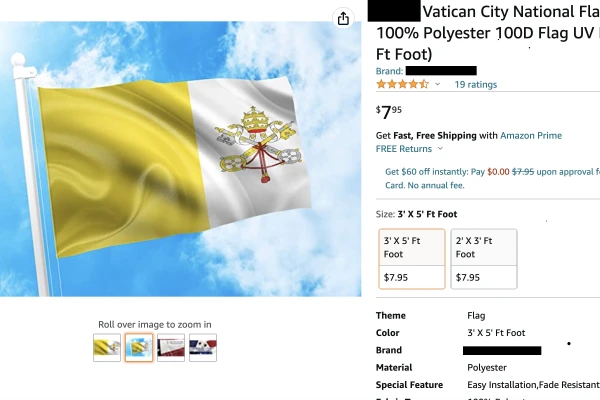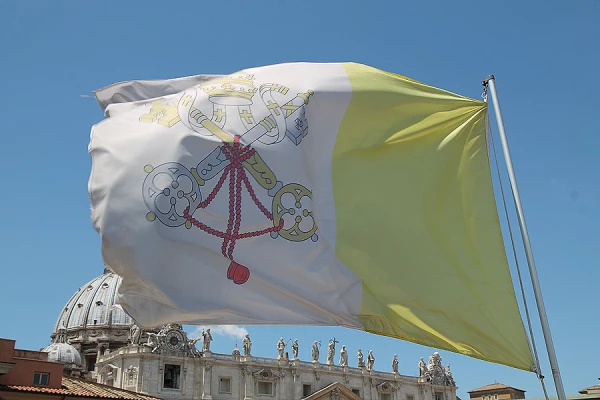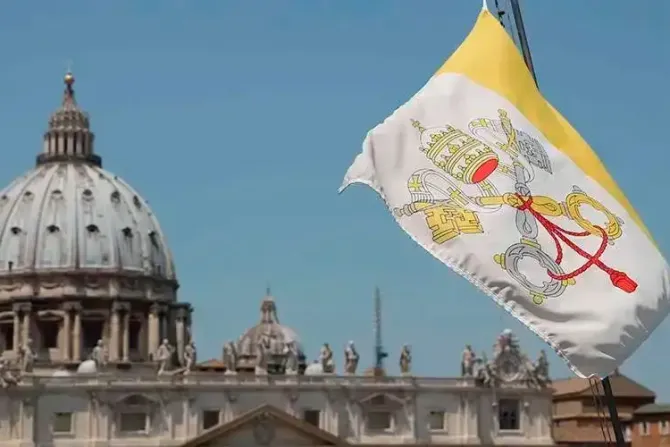St. Louis, Mo., Apr 8, 2023 / 13:00 pm
The flag of Vatican City, with its distinctive yellow and white, is instantly recognizable to many Catholics. Likely far fewer people, though, have scrutinized the papal coat of arms on the right-hand side, instead taking the intricate design — which includes famous crossed keys — for granted.
As it turns out, there’s a good chance that the coats of arms on many of the Vatican flags you’ve seen out in the world are rendered incorrectly. And it took until 2023 for the internet to start taking notice.
Imagine you wanted to print your own version of the Vatican flag. Where would you go to find a high-quality picture of one? If you’re like most internet users, your first stop would probably not be the Vatican’s official (but admittedly outdated) vatican.va website. You’re probably going to pull up Wikipedia, one of the world’s most visited websites and an endless storehouse of free image content. Flagmakers the world over appear to have done so over the years.
Imagine many people’s surprise, then, to discover that the image of the “Flag of Vatican City” displayed on Wikipedia has been wrong several times over the years, most recently from 2017 to 2022. (It was also wrong from 2006–2007.)
What is “wrong” about these flags, you might ask? It’s a small detail in the grand scheme of things but easy to spot once you know about it. The erroneous Wikipedia file includes a red disk at the bottom of the papal tiara as well as a different shade of yellow on portions of the coat of arms.
The anonymous Wikipedia editor who changed the look of the flag in 2017 wrote that he or she did so for “color correction” purposes, noting that the Vatican’s coat of arms includes the red at the bottom of the tiara. The only problem? The Vatican’s official flag design renders the coat of arms differently, with the circular bottom of the tiara in white.
The image was reverted to the correct one in 2022, but the damage was done. A casual internet search will turn up dozens of Vatican flags for sale that clearly used the incorrect image downloaded from Wikipedia. The incorrect flag has even made its way into emojis. (This whole situation gained attention last month after a Reddit user made a post about it.)

Father William Becker, pastor at St. Columbanus Parish in Blooming Prairie, Minnesota, read the Reddit post with interest and amusement. Becker, a self-described “flag guy,” has studied the Vatican flag for years and even wrote an entire book about it. He has fond memories of raising the yellow and white colors over his alma mater, the North American College in Rome.
One might imagine that the precise design specifications of the Vatican flag would be laid out for anyone to access, like they are for the flag of the United States, for example. But they aren’t. The best the Vatican provides is a web page with a verbal description and history of the flag, along with a low-resolution image showing a square version.
Becker told CNA that the saga of the Vatican flag on Wikipedia demonstrates a need for the Vatican to step in and clarify exactly what its flag should look like, especially considering the fact that Catholic churches all over the world display the Vatican flag.
It was precisely this lack of clarity on the official design of the Vatican flag that led Becker to create a website detailing, as best as he could, the correct design for the flag.
“Cultural communities in general have turned to flags in a stunning way,” Becker commented, citing in part a proliferation of cheaply made, mass-produced flags. And, anecdotally, there seems to be an ever-increasing interest in the Vatican flag as a way for Catholics to claim an identity, whether by flying a flag at home, waving it at a papal event, or by putting one in their social media profile picture.

Perhaps surprisingly, the Vatican flag is less than 100 years old, as is Vatican City itself. For more than a millennium before 1870, the pope ruled over the Papal States, large regions mainly within present-day Italy. After the Vatican lost control of the Papal States, it found itself a tiny island surrounded by an acrimonious Italy. It took nearly 60 years until the ratification of the Lateran Accords of 1929 ushered in harmony between the Vatican and Italy, and the creation of the world’s smallest sovereign country.
(Story continues below)
In the days of the Papal States, many different flags were used, but the yellow and white color scheme was a common feature. Becker said the modern design was first used by the merchant fleet in the Papal States from 1825 to 1870. In 1929, that design was chosen as the new flag of Vatican City, the sovereign country.
“It took a while in 1929 to get some flags made. The techniques of mass production weren’t available yet, and so it would have been a matter of sewing up some flags and fitting out buildings with flag staffs,” Becker noted, saying that during this time and for years afterward there was quite a bit of variation between the Vatican flags people flew, perhaps even more so than today.
“That’s kind of common with other countries too, especially those that don’t really take pains to standardize their design. [Nowadays] a flagmaker is likely to go to a source like Wikipedia, and it may vary in its accuracy,” Becker told CNA.
The same flag chosen in 1929 was reconfirmed in a revised Vatican constitution, issued by Pope John Paul II in 2000. The original Vatican flag was actually square, as indeed the official version is today. Since roughly the 1960s, though, buildings began to fly oblong state flags that followed Italy’s flag proportions, probably because most Vatican flags at the time were mass-produced there.
The flag has special significance beyond the walls of Vatican City as a marker for the Vatican’s extraterritorial properties, of which there are more than a dozen. These properties, which include major basilicas such as St. Paul Outside the Walls and St. Mary Major, are marked as the Vatican’s through their flying of the papal flag.
Becker said he hopes his website will serve as a helpful resource for anyone looking for the exact Vatican flag design, at least until the Vatican issues some kind of clarification on what exactly the flag should look like.
“The papal flag is interesting because on the one hand, the Vatican is such a small state, but the papal flag is seen all over the world. Anywhere there’s a Catholic church, you might be likely to run into a papal flag,” he said.
“It would be nice if somebody at the Holy See could, through their website or wherever, make some design specifications more available … design specifications that manufacturers could rely on a bit more.”






